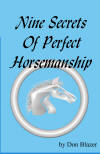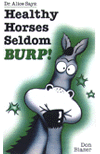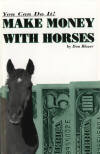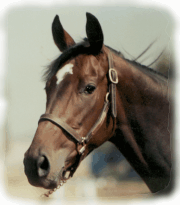
Don Blazer
Archives:
Flying Horses?
Don't eat like a Pig
Parasites
Back Sore?
Goat Hero
Communication
Foals
History of Horses
Jumping Horses
Lameness and Health
Kick the IRS
Meet Don Blazer
Books by Don Blazer
View Our Catalog
Secure Book Order Form
Don Blazer
A Horse, Of Course
Secure Book Order Form
Order using our Secure Order Form

Walter (A Horse, of Course) Spills the Oats
Nine Secrets of Perfect Horsemanship
This is a Secure Web Site
Archives:
Flying Horses?
Don't eat like a Pig
Parasites
Back Sore?
Goat Hero
Communication
Foals
History of Horses
Jumping Horses
Lameness and Health
Kick the IRS
Order using our Secure Order Form
View Our Catalog
This is a Secure Web Site
|
Horses can be affected by some strange things--such as trichobezoars,
enteroliths or phosphatic calculi.
All are concretions found in the large intestine, and sometimes, although
rarely, in the horseís stomach.
Concretions, as you may have guessed, are internal stones, about as hard
as concrete.
These infernal internal stones are made up of undigested material. They
can easily attain a diameter of five to six inches, and are often much
larger.
The ordinary weight for phosphatic calculi, which look like rounded and
polished stones, is two to three pounds. In exceptional cases they have
tipped the scales at 16 pounds.
Of course, no matter the size, they are not good for your horse.
Now, everything we ought to know about concretions we donít know, but we
have some pretty good ideas.
We donít know everything about how and why they develop, but we do know
they develop and cause trouble a lot more frequently in horses which eat a
lot of alfalfa. The Center of Equine Health, University of California,
Davis, recommends feeding oat or grass hay to reduce incidence of
enteroliths, citing the fact that 98 per cent of horses with enteroliths
had a diet of 50 per cent or more of alfalfa hay.
Interestingly, there is no factor other than alfalfa hay which comes
anywhere close to being that strongly connected to enteroliths. Of course,
no scientist will tell you that, but Iím telling you that. Iíll also tell
you the problem with concretions is much bigger in California and other
alfalfa rich states than in areas where there is little or no alfalfa.
We know concretions involve the presence of indigestible particles, such
as small pieces of iron or steel, string, plastic or a chuck of rubber. So
it is a good idea to check your horseís feed for foreign objects, and it is
a good idea to feed your horses in a manger on the ground, rather than
directly on the ground.
In the case of phosphatic calculi, it has been noted a predisposing,
though not an exciting cause, is the consumption of foods rich in
phosphates, such as bran. Lots of people like to feed bran or a bran mash
weekly. Dr. Alice suggests it may be a good idea to reduce or eliminate
bran from a horseís diet.
Dr. Alice also says a good way to decrease the pH level in the horseís
colon is to increase the grain to hay ratio. For people who donít want
their horses to be too energetic, this may not be appropriate.
Provide daily exercise and avoid prolonged stall or small pen confinement,
Dr. Alice says. Horses, she points out, need exercise to maintain
intestinal movement of feed. Frequent small feedings, rather than a couple
of large ones, will help keep bulk material moving through the large
intestine.
Trichobezoars are a very specific kind of concretion made up of hair. A
trichobezoar then is nothing more than a hair ball.
An enterolith is not very distinguished; it can be a concretion of any
variety.
According to Dr. Alice, concretions can achieve a large size without
causing problems. In some cases they are passed with manure; in some cases
they simply remain in a portion of the intestine and do not cause
discomfort.
There is no characteristic symptom which can determine the presence of
concretions. However, reoccurring colic without good reason might suggest
a trichobezoar or enterolith, according to Dr. Alice.
Problems for the horse develop when the concretion is dislodged from one
place and becomes an obstruction in a portion of the intestine.
Treatment, other than physical removal, is limited to administration of
strong purgatives or enemas. Such treatment, according to Dr. Alice, can
clear away calculi, but it can also complicate matters.
Unfortunately, trichobezoars, enteroliths and phosphatic calculi are being
seen more often. Is it the abundant availability of alfalfa hay, or just
the increased awareness of the problems of horses?
Each month you'll find a new column on our web site. We hope you'll enjoy it, and maybe
e-mail us with questions or suggestions for other
columns. A Horse, Of Course is a weekly column syndicated
by Success Is Easy. If you like the column, call your local newspaper, or local horse
publication and ask them to subscribe by contacting Success Is Easy, 13610 N. Scottsdale Rd., Suite 10-406, Scottsdale, AZ 85254
________________________________
A Horse Of Course |
Horse Books Catalog |
Meet Don Blazer
Ask Don Blazer |
Courses and Clinics |
Horse Training
Horses for Sale |
Who's Walter? |
Horse Links
Home
Info@donblazer.com
Copyright © 2000 by
Don Blazer
Success Is Easy, 13610 N. Scottsdale Rd., Suite 10-406, Scottsdale, AZ 85254
Vanndal Web Designs


